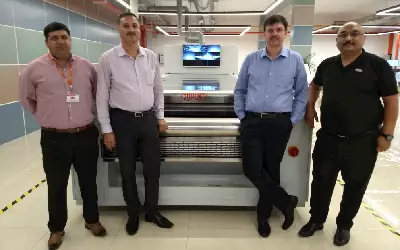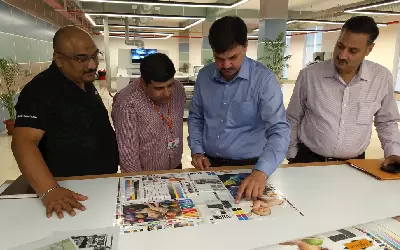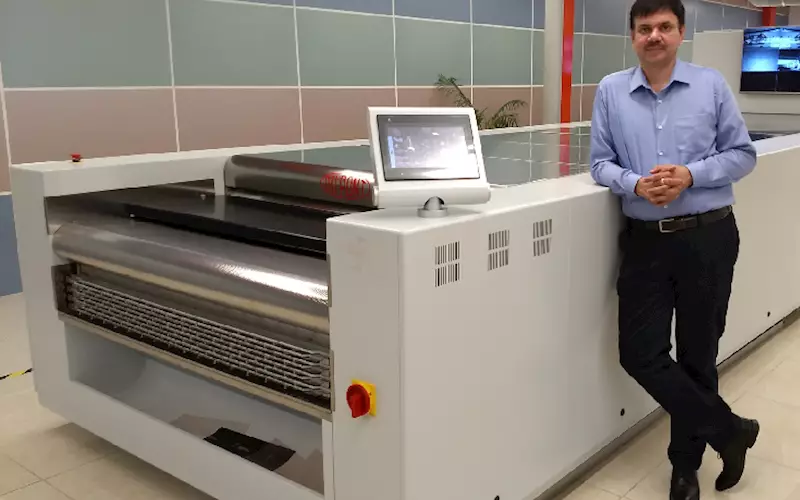Arun Pandey: In a competitive market, each new technology is a tool
Noida-based Afflatus, known for its laser-cut gravure cylinders, recently invested in India’s first inliner flexo plate processor, the DuPont Cyrel 3000 Modular InLiner Flexographic Platemaking System. Rahul Kumar talks to Arun Pandey, EVP, Afflatus, about the new investment in the context of the rising flexography market
20 Sep 2018 | By Rahul Kumar
Rahul Kumar (RK): Why did you decide to invest in DuPont Cyrel 3000 Modular InLiner System?
Arun Pandey (AP): Packaging is a growing market. New investments are taking place. Since we have long-standing relationships with our clients and brand owners and are well established with proven workflow from pre-press to the print, there was a requirement to fulfil the demand of flexo plate as well, which we surveyed, and found growing demand of high quality of plate, especially the in the wide web.
Yet, the flexible packaging market isn’t growing at the rate it was expected to. Therefore, packaging converters are now reaching out to MNCs to bring their businesses to India. Today, everyone is looking for something new to gain an edge over the competition for better yield. Now, converters have come to realise that each new technology is a tool in this competitive market.
For example, recently, I witnessed Comexi’s new gel printing technology at an open house in Spain. The technology doesn’t need any solvent. It’s just wet-on-wet printing and finally, curing with electronic beams. This is energy-efficient and generates less CO2 and VOC. We see this as another development opportunity which will pick up steam in the next couple of years, as it helps you to produce an environment-friendly print.
In this context, we see water-based printing as the next big thing. However, there are limitations of water-based printing inks. We do not have many ink suppliers because of the typical nature of the printing ink.
This is why we have chosen a technology from DuPont where high-resolution printing can be achieved. High resolution means less printing ink and solvent. This means high LPI (lines per inch). The moment you go for high LPI, ink laying gets enhanced, the consumption of printing inks and solvents goes down, and at the same time, we are able to use high-speed printing, around 300m/min or more.
RK: How DuPont helps?
AP: We were looking for an inliner as the batch processor, dryer, and light finishing. We understood the challenges. High LPI printing plates are very sensitive and handling them in a conventional way increases the chances of compromising on quality. Another challenge is handling big plates.
As we are well-versed with robotic operation in gravure cylinder, it gave us the confidence to choose a single unit with automatic handling of plates. We decided to go for a unit where we insert the plates from one place and get print-ready plates as output. DuPont helped us achieve this objective.
The exposure is a LED-curing system, which allows us to configure the perfect flat top dot without flushing nitrogen into it. At the same time, it can be customised for all types of plates.
RK: Being the first mover of the technology in India, was there any hesitation?
AP: If we want to stay ahead of the pack, we're going to have to work hard and continue to innovate. So there is no point of hesitation, to begin with, flexo. We are in gravure, and flexo starts with gravure as anilox. We understand the challenges of small dot transfers. We were looking for a solution where we could double-check the cleaning of the plates. So, it had to be an automatic machine. Secondly, we were sure of the technicality of the machine. We wanted to ensure that small polymers should be removed easily from the entire plate of 50x80-inches. It was the challenge from day one. That’s why we decided to select a system specifically designed with high efficient rollers, instead of 15-16 rollers of a conventional machine.
RK: What about skilled manpower to run such an advanced machine?
AP: You can’t call a manufacturing unit such until there is no head count of blue-collar among the white collar. As far as high-resolution printing is concerned, consistency is paramount. By using automation, we are not eliminating manpower, but we are optimising it in a different way. By adding more and more equipment, we are accumulating more and more manpower. We are enhancing skills of the existing manpower in a different way. We must have people for consistent growth. If you see the trends in plate business, in the last six to seven years, manpower also has been increased in different locations and areas.

RK: How do you train the manpower?
AP: Generally, we schedule two weeks on-job training for engineers at machine manufacturers’ sites. If we hire people for graphics, then we send them to Esko and also train them in-house in our own classroom. We have been following this practice for the last couple of years. We believe the performance of a company depends on skilled and focused employees. Every year, we send five to seven freshers to Esko for training. The same way, we send fresh operators to machine manufacturers to learn the technicalities of the machine, especially maintenance and operation for troubleshooting training of machines.
RK: How do you calculate market demand?
AP: We got to know market conditions through demographic survey research. We have a team who visits printers and understand their requirements in terms of cost, environment and other parameters. Apart from that, we are associated with many brands. Thus, we can get visibility about what brand owners are looking for. We are also closely associated with consumers.
RK: How does the current system differ from previous Cyrel systems?
AP: We do not have much experience of working on the old systems. We believe in survey-based investments. According to the latest survey, people are looking for consistency. The reason behind investing in the DuPont Cyrel InLiner system was to achieve gravure-like finishing in flexo.
RK: What are the plate requirements at Afflatus?
AP: You have to create a market for a new technology. We have invested in a new technology from DuPont to help our customers upgrade. We update our customers on the difference between the utilisation of technologies they have and what we can offer them to suffice in all areas
RK: How do you select perfect dot structure?
AP: We conducted few trials with available anilox through our R&D team and reached a conclusion that we needed different dot shapes. People are using such dots from Esko or Kodak. However, the challenge was cleaning — both from solvent and processor. We are going to achieve this with our investment in DuPont.
RK: How does the system perform vis-à-vis 1:1 image reproduction, extended colour gamut, the ability to switch between standard and hybrid dots and higher solid ink densities with no additional platemaking steps?
AP: Getting desired density is a challenge from day one. Printing ink is the key to achieve the desired density. There are inks available, but, as cost plays a major role in the market, there is a tendency to use cheaper inks. This means a compromise on pigmentation and pigment size. From day one, our focus was on achieving dots which can increase the surface energy of the plate, because higher the surface energy, better the ink transfer. We get special dots from Esko which are added on the top of flexo dots. There are flexo dots, and on specific areas, there are small tiny cells like gravure dots. It increases the surface energy of a specific area. This is how we pushed the boundaries to handle the density challenges.

RK: What about extended colour gamut?
AP: Right now, the extended colour gamut is not being used in the wide web so far in the Indian market. We are working on it and will be done very soon. Extended colour gamut means CMYK with OGV (orange, green, violet). This technology needs high-resolution plate and anilox. At the same time ink has to be of next-generation high strength low viscosity.
RK: Growth projection in flexographic print in India?AP: Poly printing/ monolayer of less than 40-50microns is getting popular in India the or sanitary napkin, cooking oil and liquid packaging, especially milk and others. Normal gravure cannot print on such thin poly, as it is sensitive in terms of stretchability. Thus, CI flexo printing presses were designed. Fortunately, or unfortunately, CI flexo printing presses are available with only flexo printing heads. That’s why flexo is getting popular.
RK: Have you visited the Cyrel manufacturing facility at its Neu-Isenburg, Germany?
AP: We were looking at an inliner system and were connected with the DuPont team. We visited their facility, evaluated on cost and way forward with the deal. There are always two ways to sail the business — either you hear the market or hear yourself to do something different, pushing the boundaries. Being Afflatus, we are always intrigued to do something new by keeping in view the consistent socio-economical sustainability. Afflatus and DuPont’s joint collaboration will certainly drive mutually potential deals and futuristic innovations.











 See All
See All